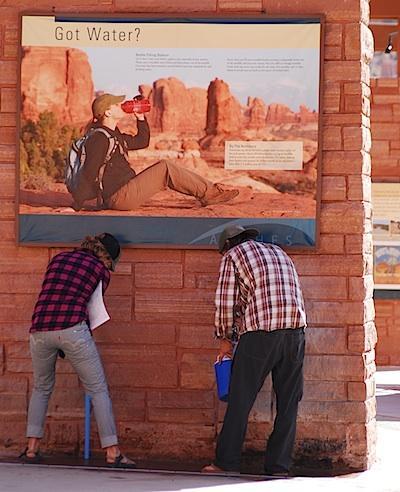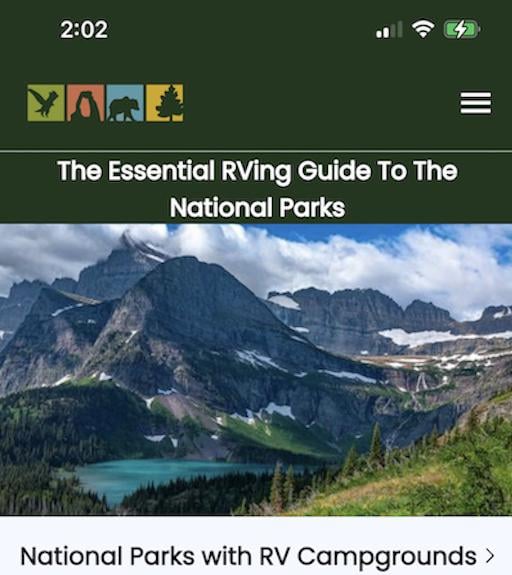
While nearly two dozen units of the National Park System have moved to ban disposable plastic water bottles and installed water filling stations, some members of Congress are still trying to overturn the ban/Kurt Repanshek file photo
A sidenote to the omnibus appropriations bill that is keeping the federal government running through September contains a single sentence that directs the National Park Service to lift its ban on the sale of disposable water bottles in parks. However, it's not legally binding.
The battle over bottled water dates to December 2011, when then-National Park Service Director Jon Jarvis gave park superintendents the option to impose a ban in a move to reduce litter in the parks and waste in landfills. Since then, at least 22 parks have banned their sale, and installed water stations for visitors to refill their reusable bottles and hydration packs.
But the move was never popular with the bottled water industry, and their lobbyists found allies in Congress to push back against the Park Service ban. Indeed, even before Director Jarvis agreed to a ban, the Park Service's commitment to a green environment was partially derailed when Coca Cola in November 2011 raised concerns over plans to ban disposable water bottles at Grand Canyon National Park with the National Park Foundation and Director Jarvis, who initially blocked the ban.
The bottle ban had been in the works for some time. In anticipation of it, Grand Canyon crews early in 2011 installed nine free water stations throughout the park at a cost of more than $300,000, according to calculations made at the time by Public Employees for Environmental Responsibility. Six were installed on the South Rim, three on the North Rim.
In coming around to agree to a ban of disposable plastic water bottles, Director Jarvis cited the Park Service's Green Parks Plan, which had a goal of reducing waste in the parks, in part by offering water bottle refilling stations in at least 75 percent of park visitor centers by 2016, the year the agency marks its centennial. (Note: The NPS failed to reach that goal.)
As for banning the sale of disposable plastic bottles, the director outlined three steps superintendents must take to implement a ban: "Complete a rigorous impact analysis including an assessment of the effects on visitor health and safety, submit a request in writing to their regional director, and receive the approval of their regional director."
In his correspondence to the field, Director Jarvis touched on the "symbolism" of banning the bottles from national parks, but also noted the potential consequences of such a move.
"Banning the sale of water bottles in national parks has great symbolism, but runs counter to our healthy food initiative as it eliminates the healthiest choice for bottled drinks, leaving sugary drinks as a primary alternative," he wrote. "A ban could pose challenges for diabetics and others with health issues who come to a park expecting bottled water to be readily available.
"For parks without access to running water, filling stations for reusable bottles are impractical. A ban could affect visitor safety; proper hydration is key to planning a safe two-hour hike or a multi-day backcountry excursion. Even reasonably priced reusable water bottles may be out of reach for some visitors, especially those with large families.
"For these reasons, the National Park Service will implement a disposable plastic water bottle recycling and reduction policy, with an option to eliminate sales on a park-by-park basis following an extensive review and with the prior approval of the regional director."
Since that directive went out, there have been occasional moves to force the Park Service to lift the ban.
Early in 2013 the bottled water industry pushed back against the ban, saying it would encourage visitors to turn to unhealthy alternatives to quench their thirsts. According to the International Bottled Water Association, research shows that in the absence of bottled water products, "63 percent of people will choose soda or another sugared drink – not tap water."
In 2015, the House of Representatives approved an amendment to overturn the ban, but then the bill it was attached to, the House Interior Appropriations bill, was pulled back due to a fight over whether Confederate flags could be displayed at national cemeteries. The Bottled Water Association at the time said the House's move to overturn the ban "is a vote for public health and safety."
Then last year the funding bill for the Interior Department drafted by the House contained language that would have blocked the Park Service from using its budget to enforce the bottle ban.
And now this year, in a report that accompanied the omnibus appropriations bill, a note directed the Park Service to put a hold on the ban.
Bottled Water.-The Committees note continued expressions of concern relating to a bottled water ban implemented under Policy Memorandum 11-03. The report provided to the Committees in April 2016, in response to a directive in the explanatory statement accompanying Division G of the Consolidated Appropriations Act, 2016, did not provide sufficient data to justify the Service' s actions. The Committees understand that the Service plans to reconsider this policy and therefore directs the incoming National Park Service Director to review Policy Memorandum 11-03 and to report to the Committees on the results of this evaluation. Accordingly, the Committees direct the Service to suspend further implementation of Policy Memorandum 11-03 and urge the Service to examine opportunities to partner with non-govemmental entities in developing a comprehensive program that uniformly addresses plastic waste recycling system-wide.
Technically, though, since that language was contained in the report and not the actual legislation, it's not binding on the Park Service to follow it. That said, when a new director for the Park Service is appointed, he/she is expected to review the policy, according to agency spokesman Tom Crosson.



Comments
With some exceptions, I would generally agree. But that is what is great about America, we all get to make the decisions of what is foolish for ourselves. At least that is the way it is supposed to be.
No, the ban is necessary. I'd say drop the ban if there was a 20 dollar per bottle deposit to be paid.
I wouldn't have a problem with a bottle deposit to fund litter patrols. $20 is a bit steep (a big bit). But a dime or a quarter might be reasonable. Oscar, why do you believe a ban is necessary and what do you believe it accomplishes.
Kurt, I suggest you take a look at the source documents (from the report to Congress) and see what those numbers really reflect, rather than rely on PEER's characterization of them. They're not actual reductions. They're the estimates included in the ban requests. Very different.
SJ, figures I was using come from NPS:
What do you know about that document, which seems more like PEER's characterization, rather than what NPS actually said? https://www.peer.org/assets/docs/nps/4_5_16_Waste_Reductions_from_%20Bot... Again, you should look at what was actually in that report to Congress.
it just makes sense, a real estate salesman and retired stockbroker knows as much as waste management pros about costs of waste disposal. can't you use common sense like he does?
Zardoz - I never was a stockbroker. And yes with a little research it is easy to get a general sense of the costs of waste disposal. But even more significant, with a little research one can see that it is the concessionaires and not the Parks that bear the vast majority of those costs. Ergo, reducing waste, whatever the number, provides little if any benefit.